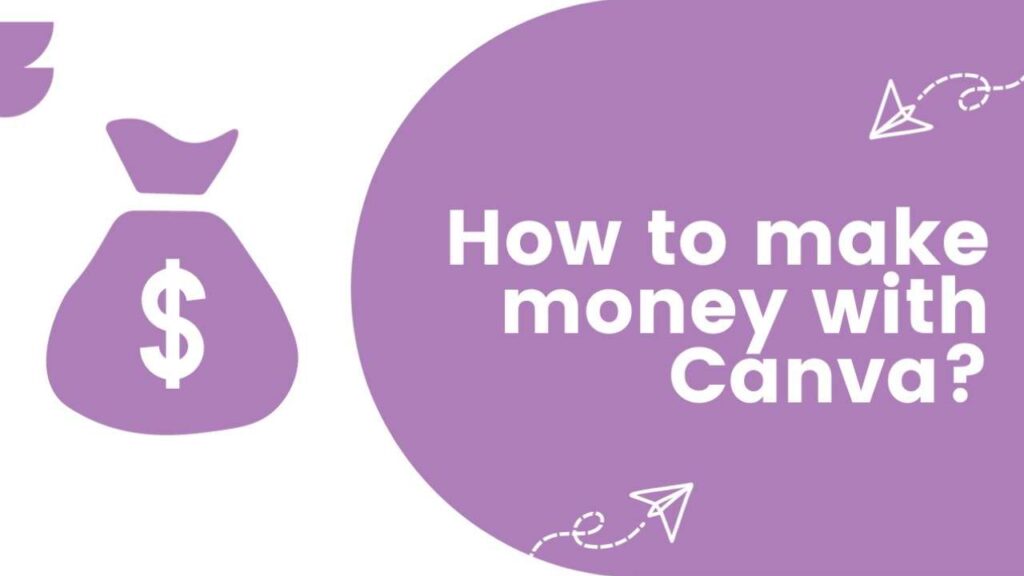THIS ARTICLE MAY CONTAIN AFFILIATE MARKETING LINKS! IN CASE YOU MAKE A PURCHASE THROUGH ONE OF THE LINKS, WE'LL GET A SMALL COMMISSION. WITH NO EXTRA CHARGES TO YOU. THANKS!!
Canva is widely used by many individuals as a graphic design tool to create visually appealing content for various purposes, such as social media, marketing materials, and presentations. While Canva itself doesn’t directly generate income, there are several ways in which you can leverage Canva to make money. Let’s explore How to make money with canva?
How to make money with Canva?
Create & sell printables & worksheets
One of the profitable and creative work is designing and selling printables and worksheets using Canva’s user-friendly platform. Here’s a step-by-step guide to help you get started:
- Step 1: Identify your target audience and niche – Determine the demand for specific types of printables or worksheets in your chosen niche. This could include areas like education, organization, self-help, wellness, etc.
- Step 2: Set up a Canva account – If you haven’t already done so, create an account on Canva. While the free version can suffice initially, the Pro version offers additional features and templates that can enhance your designs.
- Step 3: Research and plan – Understand the needs and preferences of your audience within your chosen niche by conducting thorough research. Look for popular trends currently in demand and identify any gaps that you can fill with your unique printables and worksheets.
- Step 4: Designing your materials – Utilize Canva to design visually appealing printables or worksheets by following these steps: Select the appropriate template size (e.g., A4, letter) or customize dimensions. Explore Canva’s extensive library of design elements including fonts, images, etc., to create captivating materials. Incorporate branding elements such as logos or website URLs. Organize content in a clear and user-friendly manner. If applicable, include customizable sections like fillable fields for planners or checklists.
- Step 5: Content ideas – Consider creating various types of printables or worksheets such as daily/weekly/monthly planners, to-do lists, budget trackers, educational worksheets, goal-setting sheets, etc. Canva offers a multitude of possibilities.
- Step 6: Enhance with Canva Pro features – If you’re using Canva Pro, take advantage of additional features like custom fonts, background remover, and the option to set up a brand kit. These features can make your materials more unique and appealing.
- Step 7: Branding and customization – Maintain consistency and professionalism throughout your printables and worksheets. Use a consistent color scheme, typography style, and include your logo to establish a strong brand identity.
- Step 8: Save and export – Save your designs within Canva and export them in the desired format (e.g., PDF or PNG). Ensure that the quality is high for optimal printing results.
- Step 9: Establish an online store – Choose a platform to sell your printables and worksheets such as Etsy, Gumroad or even your own website. Create enticing product listings with clear descriptions and appealing images.
- Step 10: Pricing strategy – Set competitive prices based on the value and uniqueness of your printables or worksheets. Research similar items within your niche to determine appropriate pricing ranges.
- Step 11: Promote effectively – Market your products through social media channels by leveraging email marketing campaigns or collaborating with influencers/bloggers within your niche.
- Step 12: Provide excellent customer support – Offer exceptional customer service by promptly responding to inquiries and providing necessary assistance to customers. This will help build trust in your brand.
By creating high-quality, visually appealing, and useful printables/worksheets while effectively reaching out to your target audience through various marketing strategies mentioned above, you can turn designing with Canva into a profitable business venture. Keep in mind that success may require time and effort; remain persistent while incorporating customer feedback into refining your offerings.
Print on demand
Canva, unfortunately, does not have a direct print-on-demand service for physical products. Canva’s main focus is on graphic design and digital content creation. However, you can still utilize Canva to create designs for print-on-demand products and collaborate with third-party print-on-demand services to bring your designs to life. Here’s a step-by-step guide on how you can achieve this:
- Design Your Creations in Canva: Utilize Canva’s features to craft visually appealing graphics, artwork, or any other content that you intend to print onto various products.
- Choose a Print-on-Demand Platform: There are numerous platforms available that specialize in print-on-demand services. These platforms enable you to upload your designs and have them printed on an array of items like T-shirts, mugs, posters, and more. Some well-known options include: Printful, Printify, Teespring, Redbubble, Zazzle, Society6 and Cafepress.
- Create an Account on the Chosen Platform: Register an account on the print-on-demand platform that best suits your preferences.
- Upload Your Canva Designs: Transfer the designs you crafted using Canva onto the chosen print-on-demand platform. It’s important to adhere to their specific requirements regarding image dimensions and file formats.
- Select Products: Decide which products you want to offer featuring your designs. This selection can encompass items such as T-shirts, hoodies, posters, phone cases, etc.
- Customize Products: Depending on the platform you choose, there may be additional customization options available for the products you selected. This could include choosing colors, sizes, and determining the positioning of your design.
- Set Pricing and Margins: Determine appropriate pricing for your products by considering both the base cost as well as the profit margin you desire.
- Publish Your Products: Make your products available for sale within the marketplace of the print-on-demand platform you have chosen.
- Market Your Products: Effectively promote your products through various channels like your website, social media platforms, or any other marketing strategies that are suitable for attracting potential customers.
- Order Fulfillment: Once a customer places an order, the responsibility of printing, packaging, and shipping will be handled directly by the print-on-demand platform.
It’s important to note that the success of your print-on-demand endeavor relies heavily on factors such as the quality of your designs, efficient marketing techniques, and selecting the appropriate print-on-demand partner. While Canva can serve as a valuable tool for creating visually appealing designs, it is essential to conduct thorough research and carefully choose a print-on-demand platform that aligns with both your business objectives and customer requirements. Additionally, it’s wise to stay updated on any new developments or services within the constantly evolving print-on-demand industry.

- How to Make Money as an Animator?
- How to Make Money as a Graphic Designer?
- How Much Money Graphic Designers Make?
Become Canva Contributor
Canva presents an opportunity for users to contribute their own designs and graphics to the Canva library through its contributor program. By participating in this program, you can share your creative work with a wider audience and even earn money through the Canva Pro Affiliate Program. Here’s a step-by-step guide on how to become a Canva contributor:
- Create High-Quality Designs: To become a successful Canva contributor, it is crucial to focus on creating visually appealing and high-quality designs. Make sure that your designs are original and adhere to Canva’s content guidelines.
- Set Up a Canva Account: If you don’t already have an account with Canva, you will need to create one. While the free version of Canva is sufficient for contributing, having a Canva Pro account may offer additional benefits.
- Design Unique Elements: As a contributor, you can upload various elements such as graphics, illustrations, templates, and photos. Aim to create unique and valuable design elements that other Canva users would find helpful in their projects.
- Maintain Copyright and License Rights: It is important to ensure that you have the necessary rights and permissions for the designs you upload. Canva requires contributors to either own or have the right to use the content they submit.
- Prepare Your Designs for Submission: Save your designs in formats compatible with Canva, such as PNG, JPEG, or SVG files. This way, you’ll be ready to upload them onto the platform when required.
- Submit Your Designs to Canva: Head over to Canva’s contributor portal or dashboard where you can submit your designs for review. You may also need to provide descriptions and tags that will make your designs easily discoverable by others.
- Review and Approval Process: The team at Canva will review the designs you’ve submitted; however, this process might take some time so it’s important to be patient throughout. Ensure that your designs meet Canva’s quality and content guidelines to increase your chances of approval.
- Promote Your Designs: Once your designs have been approved and added to the Canva library, take the initiative to promote them through your social media channels, website, or any other marketing platforms you have access to. This will help increase their visibility and usage.
- Earn Money through the Canva Pro Affiliate Program: As a Canva contributor, you also have the opportunity to participate in the Canva Pro Affiliate Program. This program allows you to earn a commission for referring new users to Canva Pro, providing an additional way for you to monetize your contributions.
- Continuously Update and Contribute: To maximize exposure and potential income, make sure to regularly update your portfolio with new designs. The more designs you contribute, the greater your chances of generating interest and income.
It’s important to note that Canva’s contributor program may undergo changes over time, so it is always advisable to visit their official website or contributor portal for the most up-to-date information and guidelines on becoming a Canva contributor.
Launch a Canva Course
Launching a Canva course is an incredible opportunity to share your expertise and knowledge in graphic design and Canva with a wider audience. Canva, being a popular design tool, attracts many individuals who are eager to enhance their design skills. Here are the steps to help you create and launch a successful Canva course:
- Step 1: Define Your Course Topic and Audience, Begin by deciding on the specific aspect of Canva that you would like to teach. This could be beginner-level design, advanced techniques, or niche-specific design. Additionally, define your target audience, whether it’s beginners, entrepreneurs, marketers or any other specific group you aim to reach.
- Step 2: Plan Your Course Content, Outline the topics and lessons you wish to cover in your Canva course. Create a detailed curriculum that includes main modules or sections and then break them down into individual lessons.
- Step 3: Develop Course Materials, Develop various course materials such as video tutorials, written guides, quizzes, and assignments. Utilize Canva’s features to design visually captivating slides and documents that complement your content.
- Step 4: Choose a Learning Platform, Select an appropriate platform for hosting your course. You can opt for online course platforms like Udemy, Teachable or Thinkific or choose self-hosting on your website. Ensure that the chosen platform supports all types of content you plan to provide including videos and documents.
- Step 5: Record Engaging Video Lessons, Record video lessons using screen recording software or a camera. Create engaging and informative video content that effectively demonstrates how to use Canva. For visually appealing presentation slides for your video lessons, consider utilizing Canva itself.
- Step 6: Create Supporting Documents, Create supporting documents such as step-by-step guides, templates, checklists etc., which complement your video content. These resources will assist students in understanding and practicing what they have learned.
- Step 7: Test Your Course, Before launching your course, invite a few beta testers who can go through the course. Collect feedback and make any necessary improvements or adjustments.
- Step 8: Price Your Course, Determine an appropriate pricing strategy for your Canva course. Consider the value you will be providing, analyze your competition and understand what your target audience is willing to pay. Depending on the structure of your course, you can offer a one-time purchase or a subscription model.
- Step 9: Market Your Course, Promote your course through various marketing channels including your website, social media platforms, email marketing, and paid advertising. Utilize visually appealing graphics created with Canva to effectively promote your course.
- Step 10: Launch Your Course,Once everything is in place, it’s time to officially launch your Canva course. Make an announcement and start accepting enrollments.
- Step 11: Provide Support and Engagement, Be available to answer any questions that students may have throughout the duration of the course. Foster engagement through discussions, Q&A sessions and feedback.
- Step 12: Gather Feedback and Continuously Improve, After running the course for a while, collect feedback from your students and use it to improve upon both the content and delivery of future courses.
Creating and launching a successful Canva course requires not only design skills but also instructional expertise and effective marketing strategies. By adopting the right approach along with a well-structured curriculum, you can empower others to excel in using Canva for their graphic design needs.
Join Canva affiliate program
Becoming an affiliate for Canva presents an opportunity to earn commissions by promoting their innovative design platform and referring new users. Canva’s affiliate program is a fantastic way to monetize your influence and marketing efforts. Allow me to guide you through the steps to join the Canva affiliate program:
- Step 1: Sign Up for the Canva Affiliate Program, Begin by navigating to the official Canva website. Once there, scroll down to the bottom of the page and locate the “Affiliates” link in the footer section. Give it a click!
- Step 2: Apply for the Affiliate Program, When you land on the affiliates page, you’ll discover valuable information about Canva’s affiliate program, including its terms and operational details. Take some time to review this information carefully, ensuring that it aligns with your goals and resonates with your audience. If everything checks out, proceed by clicking on either “Apply Now” or “Sign Up” to officially join.
- Step 3: Complete the Application, You’ll be prompted to fill out an application form that requests specific information about yourself, such as details related to your website, social media presence, and marketing strategy. Provide these necessary details accurately and submit your application. Fear not! The dedicated team at Canva will carefully review it.
- Step 4: Wait for Approval, Patience is key at this stage! The diligent team at Canva will thoroughly evaluate your application based on their criteria. If you meet their requirements (which I’m sure you will), they will grant you approval as a valued member of their affiliate program. Please note that approval times may vary.
- Step 5: Access Your Affiliate Dashboard, Upon receiving approval, you’ll gain access to a personalized affiliate dashboard provided by Canva themselves. This dashboard serves as your hub for generating unique affiliate links, keeping track of referrals, and monitoring your earnings.
- Step 6: Promote Canva and Watch Your Commissions Grow, Now comes the exciting part! Begin promoting Canva using your customized affiliate links and implement your marketing strategies. There are numerous avenues you can explore for promotion, such as crafting engaging blog posts, leveraging social media platforms, harnessing the power of email marketing, or any other channel that resonates with your target audience. As an affiliate, each time someone clicks on your affiliate link and signs up for a paid Canva Pro subscription, you’ll earn a commission for that referral. It’s worth mentioning that the commission amount may vary, and Canva occasionally offers additional incentives and bonuses to their esteemed affiliates.
- Step 7: Receive Payouts, Canva values their affiliates and ensures timely payouts. They typically adhere to a regular payment schedule, whether it be monthly or quarterly. Rest assured that you’ll receive your hard-earned commissions through the payment method specified in your affiliate account settings.
- Step 8: Adhere to Canva’s Affiliate Guidelines, To maintain your status as an esteemed Canva affiliate, it’s imperative that you adhere to their guidelines and terms of service. Ethical promotion is key here! Ensure that you represent Canva in an honest and transparent manner while targeting an audience genuinely interested in their remarkable services. Please remember to disclose your affiliate relationship as required by regulations—transparency is always appreciated.
Please keep in mind that program details, commission rates, and terms may evolve over time. To stay updated with the most current information regarding the Canva affiliate program along with its terms and conditions, I highly recommend visiting the official Canva website.

To thrive in this venture of generating revenue through affiliations with extraordinary platforms like Canva, honing your design skills is crucial alongside building a compelling portfolio. Additionally, effective marketing strategies will play a significant role in attracting clients who will benefit from utilizing Canva’s features aligned with current design trends—offering exceptional value to both your clients and customers.







